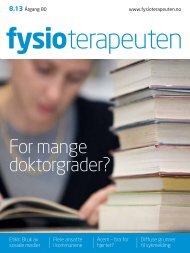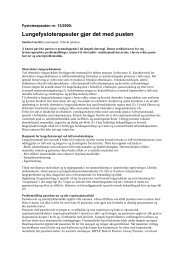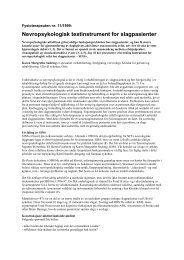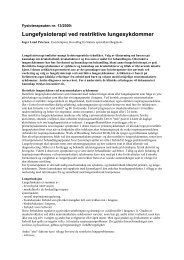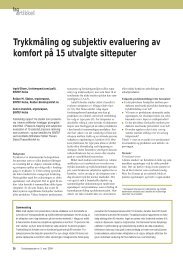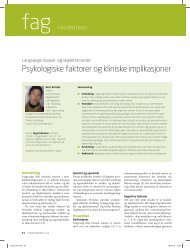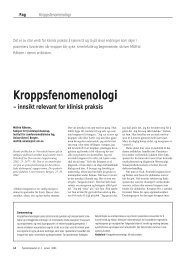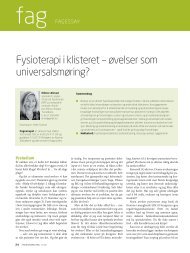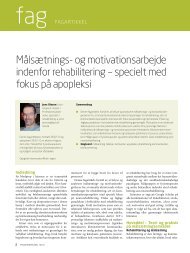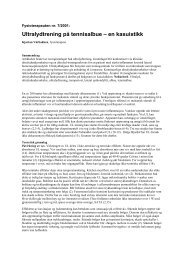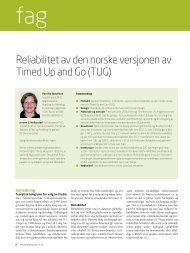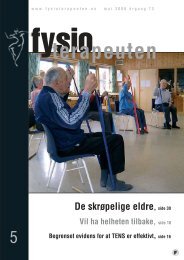1/11 - Fysioterapeuten
1/11 - Fysioterapeuten
1/11 - Fysioterapeuten
Create successful ePaper yourself
Turn your PDF publications into a flip-book with our unique Google optimized e-Paper software.
FAG BLIKK PÅ FORSKNING<br />
BLIKK PÅ FORSKNING<br />
Commentary<br />
More than 12 million premature infants are born worldwide each<br />
year (March of Dimes Foundation 2009). Despite improvements<br />
in neonatal care, infants born preterm remain at high risk for<br />
neurodevelopmental impairments (Bode et al 2009). This new<br />
randomised controlled trial evaluated the VIBeS Plus program,<br />
a treatment program delivered during the first year of life aimed<br />
at improving infant cognitive, motor, and behavioural outcomes.<br />
An important additional aim was to support the mental health of<br />
the infants’ primary caregivers. Compared to those in the control<br />
group, parents reported that the infants in the treatment group<br />
had better behavioural outcomes and the primary caregivers<br />
themselves had reduced anxiety and depression.<br />
This study provides clinicians with a systematic way in which<br />
to deliver early intervention to this high risk group of infants once<br />
they leave the hospital. The VIBeS Plus program combined the<br />
best aspects of a number of other early intervention programs<br />
and was delivered by two health care professionals, physiotherapists<br />
and psychologists. The burden of care was relatively low for<br />
the health care professionals, seeing the families nine times over<br />
twelve months. Nevertheless, the long-term benefit of the VIBeS<br />
Plus program requires evaluation, particularly since the effects of<br />
30 FYSIOTERAPEUTEN 1/<strong>11</strong><br />
Blikk på forskning utarbeides i samarbeid med Journal of Physiotherapy<br />
(Australia). Tidsskriftet trykker forskningspresentasjonene under betegnelsen<br />
Critically appraised Papers, CAPs.<br />
A preventive care program for very preterm infants improves infant behavioural<br />
outcomes and decreases anxiety and depression in caregivers<br />
Synopsis<br />
Summary of: Spittle AJ et al (2010) Preventive<br />
care at home for very preterm infants<br />
improves infant and caregiver outcomes at<br />
two years. Pediatrics 126: e171–e178. [Prepared<br />
by Nora Shields, CAP Editor.]<br />
Question: Does a home-based preventive<br />
care program improve cognitive, language,<br />
and motor development in very preterm<br />
infants, and mental health in their primary<br />
caregivers?<br />
Design: Randomised, controlled trial<br />
with concealed allocation and blinded outcome<br />
assessment.<br />
Setting: In the homes of participants in<br />
Australia.<br />
Participants: Infants born at less than 30<br />
weeks gestational age, with no major congenital<br />
brain anomalies were included. Infants<br />
were excluded if the family did not live<br />
within 100 km of the recruiting centre or if<br />
their family did not speak English. Randomisation<br />
of 120 participants allocated 61 to<br />
an education and support program group<br />
and 59 to a control group.<br />
Interventions: Both groups received stan-<br />
dard follow-up care, including access to a<br />
maternal and child health nurse and referral<br />
to early intervention services if deemed<br />
appropriate. In addition, the intervention<br />
group received nine, 90–120 minute visits<br />
over one year by a psychologist and a physiotherapist.<br />
The visits consisted of education<br />
on infant self-regulation, techniques<br />
to improve postural stability, co-ordination,<br />
and strength, and parental support.<br />
Outcome measures: The primary outcomes<br />
were the cognitive, language, and motor<br />
development domains of the Bayley Scales<br />
of Infant and Toddler Development III at<br />
two years corrected age and the Hospital<br />
Anxiety and Depression Scale for the primary<br />
caregivers. Secondary outcome measures<br />
were child behaviour and emotional<br />
regulation assessed using the four domains<br />
of the Infant-Toddler Social and Emotional<br />
Assessment (externalising, internalising,<br />
dysregulation, and competence).<br />
Results: <strong>11</strong>5 participants completed the<br />
study. At two years corrected age, the cognitive,<br />
language, and motor domains of the<br />
Bayley scales did not differ significantly bet-<br />
some early intervention programs do not appear to be sustained<br />
(Spittle et al 2007). Moreover, although the overall effects of the<br />
program were modest, the program may have influenced growth<br />
and development in areas not assessed in this study (eg Casey et<br />
al 2009). Finally, implementing a «preventive» program once the<br />
infants are discharged may be too late to effect changes in development<br />
long-term. Alternatively, the quality of developmental<br />
outcomes may be enhanced if the infants receive intervention<br />
continuously from birth through the first years of life (McAnulty<br />
et al 2009).<br />
Liisa Holsti<br />
University of British Columbia, Canada<br />
ween the groups. Three of the four domains<br />
of the Infant-Toddler Social and Emotional<br />
Assessment improved significantly more in<br />
the intervention group than in the control<br />
group at two years corrected age: externalising<br />
by –4.1 units (95 percent CI –8.2 to<br />
–0.02), dysregulation by –8.7 units (95 percent<br />
CI –13.2 to –4.2), and competence by<br />
6.3 units (95 percent CI 0.7 to <strong>11</strong>.8). The<br />
groups did not differ significantly on the internalizing<br />
domain. The primary caregivers<br />
in the intervention group reported lower levels<br />
of anxiety and depression on the Hospital<br />
Anxiety and Depression Scale, compared<br />
with those in the control group by –2.0 units<br />
(95 percent CI –3.2 to –0.7 units) for depression<br />
and –3.1 units (95 percent CI –4.5 to<br />
–1.6) for anxiety.<br />
Conclusion: A home-based preventive<br />
care program for very preterm infants and<br />
their families improved behavioural outcomes<br />
for infants and decreased anxiety and<br />
depression in primary caregivers. The program<br />
did not have any significant effects on<br />
cognitive, language, for motor development<br />
of the children at corrected age of two years.<br />
References<br />
March of Dimes Foundation (2009). NY.<br />
Bode M et al (2009) Pediatrics 124: 866–874.<br />
Spittle A et al (2007) Cochrane Database Syst Rev: CD005495.<br />
Casey P et al (2009) Arch Pediatr Adolesc Med 163: 1046–1053.<br />
McAnulty G et al (2009) Acta Paediatrica 98: 1920–1926.<br />
Litteratur<br />
Holsti L. Appraisal critically appraised paper. J Physiother 2010; 56(4): 277.



